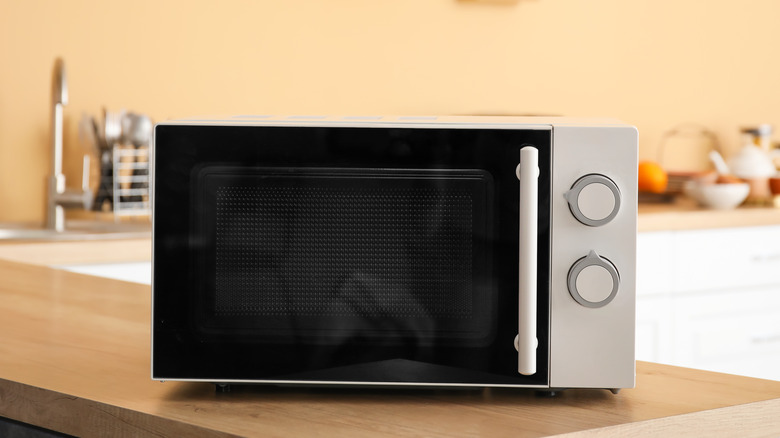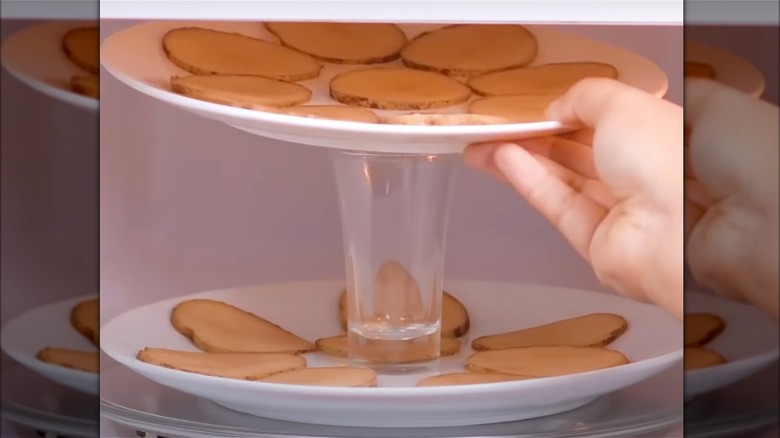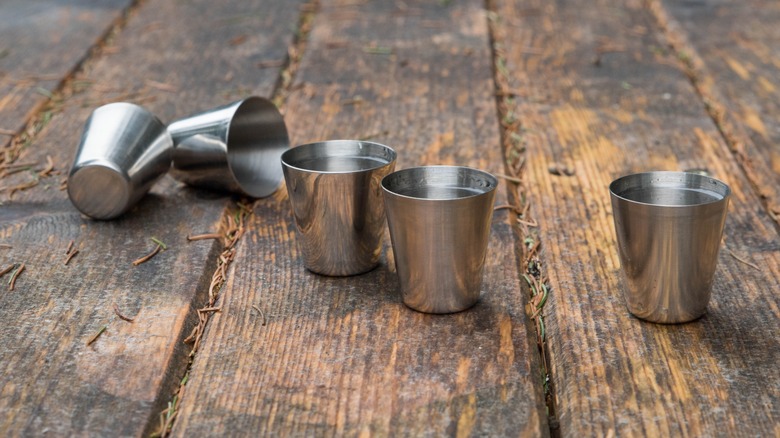The Shot Glass Tip For Microwaving 2 Tiers Of Food At Once
The microwave is a versatile piece of technology, delectably popping shiny kernels of corn, reheating those precious leftovers, or rapidly thawing that frozen dish in a whizz. It was invented in 1945 by American engineer Percy Spencer who, while standing next to a machine that emitted high-frequency radio waves, realized that the chocolate candy in his pocket had started to melt. Microwaves have come a long way since that moment. And, while this hack may not be a technological advancement, using a shot glass to microwave two tiers of food at once is a savvy one.
This tip involves placing a plate into a microwave, positioning a shot glass upright in the center of the dish, and then carefully sitting another plate on top of the shot glass. Ensure everything is balanced, then gently close the microwave door and press start. This is the ideal hack for thin or flat dishes that fit compactly on a plate, such as preparing potato chips. Otherwise, you can easily reheat or defrost food also using this two-tiered method. It's a balancing act for sure, and works best for certain dishes compared to others. However, it does present a unique and accessible timesaving solution.
2-tier shot glass considerations
Before giving this tip a go, it's best to note some safety factors. Firstly, ensure your microwave is secure. If you're likely to turn it on and your microwave will give a little shimmy as it spins, this tip may not work. Ideally, you need everything to be stable so as not to wobble off or unsettle the shot glass in the center.
Cooking two dishes simultaneously may also require an increase in the cooking time. This is because the extra food in the microwave brings with it more moisture, a factor that also varies based on the type of food being heated. Portion sizes and shapes that are alike might have similar cooking times, while significant differences in portion size can make regulation more challenging.
Also, considering the moisture content of either tier is vital. A dry dish, such as a chicken breast, may take two minutes to reheat, while a wet dish, like soup, may take three. Whenever cooking meat in the microwave, it's crucial to follow safety rules to mitigate the chance of food poisoning. Furthermore, only use this hack to cook the same food on each tier, as different types of food will require different cooking times. Lastly, different types of microwaves will have varying power. It's best to experiment with heating times until your dishes have reached an internal temperature considered safe to consume.
A note on materials
There are many styles of shot glasses available, from garishly-colored glasses reminding you of an incredible weekend in Las Vegas to the simple yet sleek stainless steel shooters. While you may believe all shot glasses made from glass can be placed into the microwave, this is not always the case. Shot glasses made from most types of glass or ceramic should be okay, but crystal and handmade pottery aren't suitable, so it would be better to avoid these. Alongside these materials, metal shot glasses, including stainless steel, will risk reflecting the microwaves and potentially causing a fire hazard. In this sense, they join a list of other materials you should never place inside your microwave.
The same consideration should also be given regarding the plates you use. Ensure the plates are microwave safe: This is usually indicated on the underside of the plate, or the information should be available online on the manufacturer's website. If you're reheating the contents of plastic containers, ensure the plastic can also withstand the microwaves. The top-tier in particular may become flimsy as it heats and could bend over either side of the shot glass. A sturdy top and bottom tier is preferred. This tip would be possible with bowls instead of plates, too, but make sure there's enough height in your microwave.
The next time you're pondering how to microwave two dishes simultaneously, try this shot glass trick — just prioritize safety!


